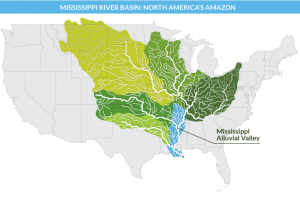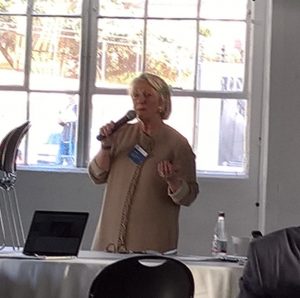 Today is earth day and on Wednesday I met the most interesting woman who is working to restore one million acres in the Mississippi River Basin, North America’s Amazon. This area is the third largest water shed on earth. It spans 31 states and two Canadian provinces. It covers about 40% of the continental U.S. Google Mississippi River Basin, you’ll be amazed.
Today is earth day and on Wednesday I met the most interesting woman who is working to restore one million acres in the Mississippi River Basin, North America’s Amazon. This area is the third largest water shed on earth. It spans 31 states and two Canadian provinces. It covers about 40% of the continental U.S. Google Mississippi River Basin, you’ll be amazed.
PJ Marshall, and her husband Marvin, embarked on this journey in the aftermath of Hurricane Katrina. They started the Restore the Earth Foundation based on a solid business model developed from their careers in business. They matched private investment in a program that would have verifiable returns. They did well and their metrics were admirable. But then they learned that their efforts, along with others, to restore coastal wetlands, was not keeping pace with the ecological degradation. Louisiana wetlands loose an area the size of a football field every hour. In the Basin, 80% of forested wetlands have been degraded. This area also contains the largest concentration of underserved communities in the U.S. As preservation has past, and now it’s about restoration, the challenge is daunting. Their plan, restore one million acres over the next 15 years. Once achieved, they project that the restored wetlands will lead to a 2% reduction in total U.S. climate footprint and a 12.5% reversal of the “dead zone” in the Gulf of Mexico.
 While the environmental impact is both astounding and critical, it is the financial model that is truly amazing. They do this through a revolving fund and their EcoMetrics model. It leverages public funds through private funds, turning $1 into $9 of integrated value. Benefits include recreational activities restored, jobs created both directly and indirectly, enhanced biodiversity, build intellectual capital and with financial capital including offset credits, revenue from timber and through sales of restored land. I won’t go into the details here, but their website illustrates.
While the environmental impact is both astounding and critical, it is the financial model that is truly amazing. They do this through a revolving fund and their EcoMetrics model. It leverages public funds through private funds, turning $1 into $9 of integrated value. Benefits include recreational activities restored, jobs created both directly and indirectly, enhanced biodiversity, build intellectual capital and with financial capital including offset credits, revenue from timber and through sales of restored land. I won’t go into the details here, but their website illustrates.
Their mission is to “restore the earth’s essential forest and wetland ecosystems, delivering outstanding environmental, social and economic returns.” This is a plan that I think even the most skeptical of climate change can get behind.
